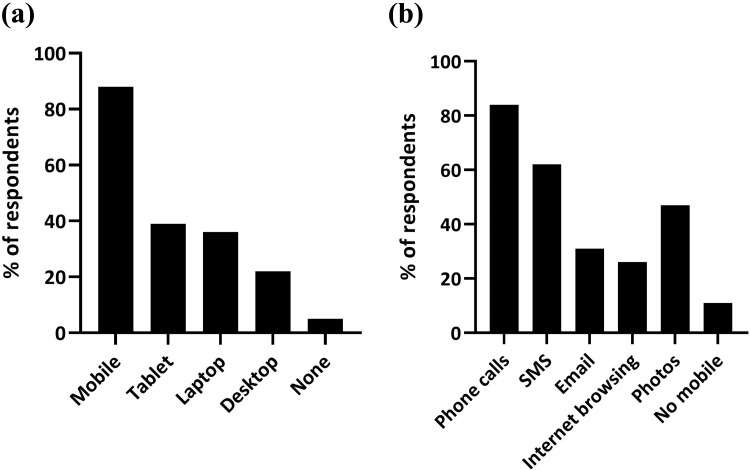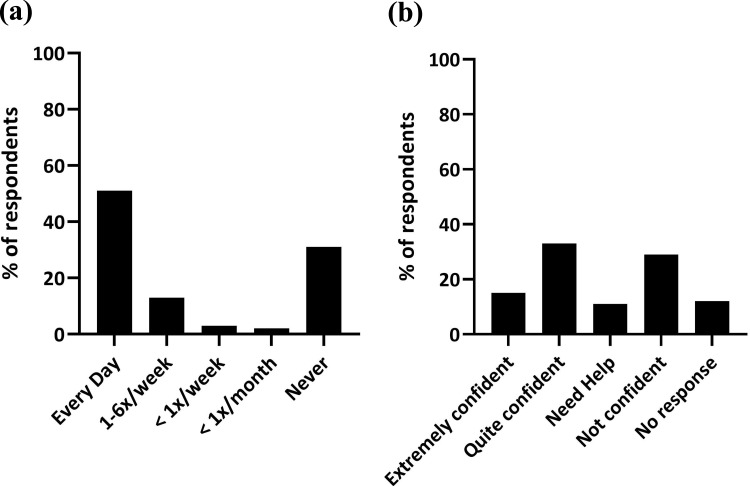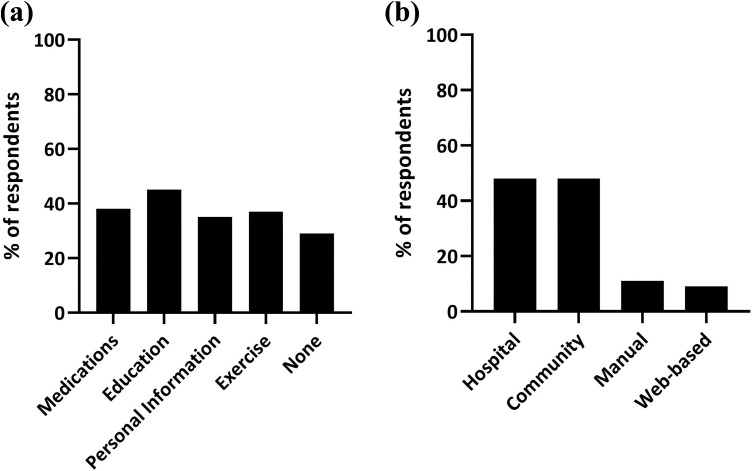Abstract
Remote models of pulmonary rehabilitation (PR) are vital with suspension of face-to-face activity during the COVID-19 pandemic. We surveyed digital access and behaviours and PR delivery preferences of current PR service users. There was significant heterogeneity in access to and confidence in using the Internet with 31% having never previously accessed the Internet, 48% confident using the Internet and 29% reporting no interest in accessing any component of PR through a Web-based app. These data have implications for the remote delivery of PR during the COVID-19 pandemic and raise questions about the current readiness of service users to adopt Web-based delivered models of PR.
Keywords: PR, home-based exercise, Internet, COVID-19
Introduction
Pulmonary rehabilitation (PR) is commonly delivered in outpatient settings but due to the Coronavirus Disease 2019 (COVID-19) pandemic and suspension of face-to-face clinical encounters, alternative ways of delivering PR are vital. Many home-based options involve digital platforms and Internet access.1–3 However, contemporary data on the digital access and behaviour of PR service users are limited. We aimed to investigate digital access and behaviour and PR delivery preferences in current service users.
Methods
Harefield Hospital PR team, UK, initiated a survey of all service users between 24 February 2020 and 9 March 2020 as part of a service-improvement initiative. It comprised basic demographic details and questions on access to digital devices, confidence, frequency and motivation in using these devices; willingness to view PR components digitally; and PR delivery preference. Data were summarised using descriptive statistics and bar charts.
Results
Of the 193 surveyed, responses were received from 170 (88%); 133 (78%) and 7 (4%) were enrolled in conventional and home-based PR, respectively, and 30 (18%) were awaiting enrolment. Baseline demographics were age 72 (10) years (mean (SD)), 52% women, and primary respiratory diagnosis of 68% COPD, 11% chronic asthma, 7% bronchiectasis, 5% interstitial lung disease and 9% other diagnoses.
Most respondents possessed a mobile phone (89%), but access to other devices was more heterogenous (Figure 1(a)). In all, 31% and 26% reported using mobile phone for emailing or Internet browsing, respectively (Figure 1(b)).
Figure 1.
(a) Percentage of respondents with access to digital devices (b) Percentage of respondents using mobile phone functions. SMS: Short Message Service (Text messaging).
Fifty-one per cent used the Internet daily, but 31% had never accessed it (Figure 2(a)). Older age, but not sex, was associated with a lack of Internet access (odds ratio (95% confidence interval) 0.94 (0.91 to 0.99); p < 0.01). Less than half felt “extremely” or “quite” confident using the Internet (Figure 2(b)). Only 16% had experience of video calling.
Figure 2.
(a) Frequency of Internet access. (b) Confidence with using the Internet.
Self-management education was the most popular (45%) PR component respondents were interested in accessing digitally (Figure 3(a)), with 29% reporting no interest in accessing any PR information digitally.
Figure 3.
(a) Percentage of respondents who would access components of PR through an app from a digital device. (b) Percentage of respondents who would like different modes of PR delivery.
The majority of respondents (79%) preferred PR delivered face to face in a hospital or community setting, with 11% and 9% stating a preference for an exercise manual at home supervised by weekly telephone calls or a Web-based app with no supervision (Figure 3(b)).
Discussion
This study provides contemporary data on digital access and behaviour of PR service users. Our main finding is the wide variability in Internet access and confidence which has implications for the remote delivery of PR during the COVID-19 pandemic and raises questions about the readiness of service users to adopt digital PR.
The survey was initiated in anticipation that the COVID-19 pandemic would lead to restrictions on face-to-face clinical encounters. Indeed, the British Thoracic Society advised the suspension of face-to-face PR on 23 March 2020 and encouraged the use of online PR resources.
Although recent trials of PR delivered through Web-based platforms have shown promise, a common limitation was selective trial population. For example, one study included only those with Internet access and the ability to operate a Web platform2 and in another more participants were excluded because of no Internet access (n = 111) than participants recruited (n = 103).1 These trials provide limited information on the digital ability of unselected PR service users.
A strength of our study is that it provides contemporary real-world information on the feasibility of digital interventions during the COVID-19 pandemic. However, as a large proportion of respondents were enrolled in conventional PR, views on the acceptability of home-based options were likely to be biased.
In conclusion, digital access and behaviour among PR service users is heterogeneous with a significant proportion unable or unwilling to access Web-based healthcare. This has implications for remote PR delivery during the COVID-19 pandemic and provides insight into the feasibility of digital PR adoption.
Acknowledgements
We would like to express our gratitude to the patients for participating in this study. We would also like to thank the staff of the Harefield PR Unit for their help with data collection.
Footnotes
Author contributions: WD-CM and CMN contributed equally to this work. WD-CM, CMN helped in the concept and design of the study; OP, REB, SP, JAW contributed to acquisition of data; OP, WD-CM, CMN were involved in data analysis; OP, WD-CM, CMN drafted the manuscript; all authors contributed to critical revision of manuscript for important intellectual content; and all authors approved the final manuscript.
Declaration of conflicting interests: The author(s) declared the following potential conflicts of interest with respect to the research, authorship, and/or publication of this article: OP, MA, REB, SP and JAW have no competing interests to report. SSCK reports personal fees from Novartis, outside the submitted work. WD-CM reports personal fees from Jazz Pharmaceuticals, personal fees from Mundipharma, personal fees from Novartis, grants from Pfizer, non-financial support from GSK, grants from National Institute for Health Research, grants from British Lung Foundation, outside the submitted work. CMN reports personal fees from Novartis, outside the submitted work.
Funding: The author(s) received no financial support for the research, authorship, and/or publication of this article.
ORCID iDs: Oliver Polgar  https://orcid.org/0000-0002-1320-2096
https://orcid.org/0000-0002-1320-2096
Claire M Nolan  https://orcid.org/0000-0001-9067-599X
https://orcid.org/0000-0001-9067-599X
References
- 1. Chaplin E, Hewitt S, Apps L, et al. Interactive web-based pulmonary rehabilitation programme: a randomised controlled feasibility trial. BMJ Open 2017; 7(3): e013682. [DOI] [PMC free article] [PubMed] [Google Scholar]
- 2. Bourne S, DeVos R, North M, et al. Online versus face-to-face pulmonary rehabilitation for patients with chronic obstructive pulmonary disease: randomised controlled trial. BMJ open 2017; 7(7): e014580. [DOI] [PMC free article] [PubMed] [Google Scholar]
- 3. Tsai LLY, McNamara RJ, Moddel C, et al. Home-based telerehabilitation via real-time videoconferencing improves endurance exercise capacity in patients with COPD: the randomized controlled TeleR Study. Respirology 2017; 22(4): 699–707. [DOI] [PubMed] [Google Scholar]





